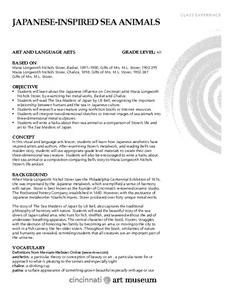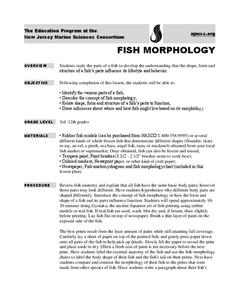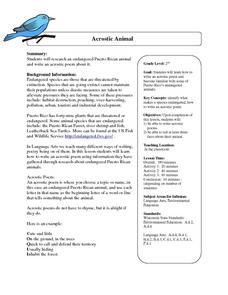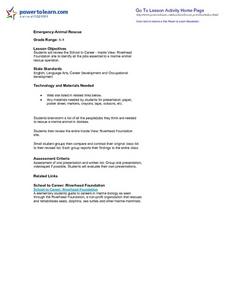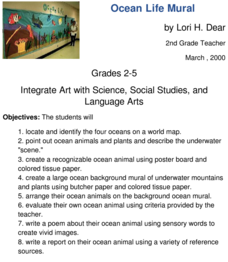Channel Islands Film
Dark Water: Lesson Plan 2 - Grade 3
A discussion of bioluminescence launches an investigation of animal adaptations. After re-watching the opening minutes of Dark Water, class members listen to a reading of What Do You Do with a Tail Like This, and then create a new...
Curated OER
Japanese-Inspired Sea Animals
Students explore the Japanese influence on Cincinnati artist Maria Longworth Nichols Storer, by examining her metal works, Basket and Chalice. They research a sea creature using nonfiction books or Internet resources. Students write a...
Curated OER
Picasso's Art Styles
Students explore the life and artistic contributions of Pablo Picasso. They create a clay animation depicting one of Picasso's art periods.
Curated OER
Helpful Animals and Compassionate Humans in Folklore
Learners define elements of stories from around the world that include helpful animals. They explore animal character motivations and use graphic organizers to compare and contrast animal stories from different cultures.
Curated OER
Under the Sea
Young scholars imagine and describe fictitious sea animals that might live in the ocean. After reading an article, they reflect on new discoveries found in the ocean recently. Using the internet, they research the interdependence of...
Curated OER
Sea Slides
Fifth graders work in groups of three to produce a slide show (at least 5 slides, no more than 8) in Kid Pix. They work in groups, and plan a slide show of at least 5 slides for presentation on the different sea life they studied during...
NOAA
It's a Roughy Life
Scientists recently discovered several previously unknown species at the Bear Seamount off the coast of New England. Scholars research these new species — benthopelagic, benthic, and seamount fish — and find out what makes them...
Consortium for Ocean Science Exploration and Engagement (COSEE)
Fish Morphology
Life comes in all different shapes and sizes, and fish are no exception. Here, young scientists create fish prints as they learn how specific characteristics allow different species to survive in their particular habitats.
Curated OER
Starfish Project: Ceramics
After exploring the wonders of ocean life found in tidal pools, explore ocean life through ceramic art. Kids use texturing and the pinch-and-pull technique to create starfish, just like the ones found at the seashore. Suggested...
Curated OER
Acrostic Animal
Second graders listen as the teacher describes how an acrostic poem is written. They research an endangered animal of Puerto Rico. Students write an acrostic poem as a class, and then individually about the animal they research. Students...
Curated OER
Art/Ocean Scene
Students draw and color an ocean scene based on the paintings of Wyland. In this ocean art lesson plan, students view slides of seascapes before they complete their project using oil pastels.
Curated OER
Sea Turtle
Students listen to a story about a sea turtle sanctuary. They participate in a discussion about the sea turtles. They analyze some of the hazards that can hurt sea turtles and brainstorm ways to help the problem. They write and...
Curated OER
Be an Artist: Sea Turtle
In this science worksheet, 3rd graders will use visual clues in a grid to complete an exact image replica. Following the original line segments in each box, students will create the image of a sea turtle.
Curated OER
Persuasive Writing-"Those Whales"
Use an article about an Orca killing a trainer to help writers complete a persuasive essay. The article, other templates, and models are attached. Scholars divide up into groups of three where each person takes a different role,...
Curated OER
Now You See Me, Now You Don't
Bioluminescence fascinates most upper elementary scientists. Display images of different glowing deep-sea organisms and discuss their environment. Young biologists then experiment with images and different colors of filtered light. In...
Curated OER
Caught in a Net
Young scholars read and discuss the bycatch of the sea and the economic impact of taking bycatch away. In this bycatch lesson plan, students discuss the rights of fisherman and observe pictures of sea animals.
Curated OER
Whale Song Acrostic
What do whales sing about? Invite your class to imagine the thoughts of whales before writing acrostic poems on the topic. The plan blends together a bit of life science with plenty of opportunities for creativity and writing.
Curated OER
Emergency-Animal Rescue
Students brainstorm list of people and jobs they think are needed to rescue distressed marine animal, review entire Inside View: Riverhead Foundation site, create revised list, compare and contrast original class list to revised list,...
Curated OER
On the Seashore
Students read the book On the Seashore and complete activities such as reading a book, color and cut out animal cards, model rock making, shell graphing, shell patterns, and more. In this seashell lesson plan, students use the sea...
Curated OER
Mythical Beasts
Students explore literature and art forms containing creatures that are part human and part animal, such as the Greek Sphinx, Neptune, or the Green Centaur. Individually, students write a poem or short story to create a character with...
Curated OER
Creature Seekers
Does it actually exist? Consider the sighting of a giant squid, much like the one that appears in 20,000 Leagues Under the Sea. Middle and high schoolers read the article One Legend Found, Many Still to Go, and research other mysterious...
Curated OER
Ocean Life Mural
How many oceans can you name? First, have learners try to name as many oceans as they can, and then have them locate and identify the oceans on a world map. They create a recognizable ocean animal using poster board and tissue paper....
Curated OER
Introduce Vocabulary: From Tadpole to Frog (Pfeffer)
Take an amphibious journey with budding readers as you explore vocabulary in Wendy Pfeffer's informative book From Tadpole to Frog. This text is the backdrop of a vocabulary exercise based on six words: fertilize,...
California Academy of Science
Fish Forms
I've said it before, and I'll say it again, you can add art to any lesson! While little learners are discovering why fish have specific body parts such as, scales, fins, and gills, they start making three-dimensional fish forms. Children...

